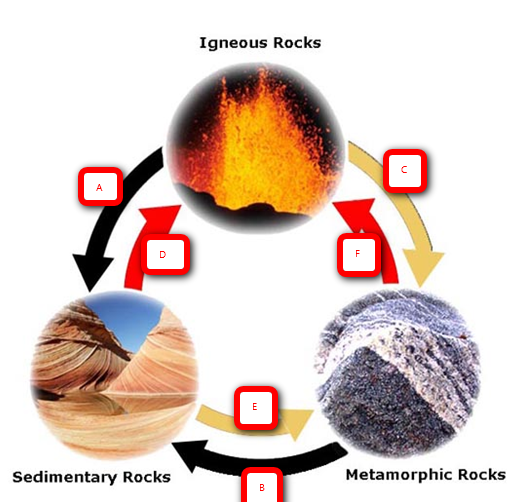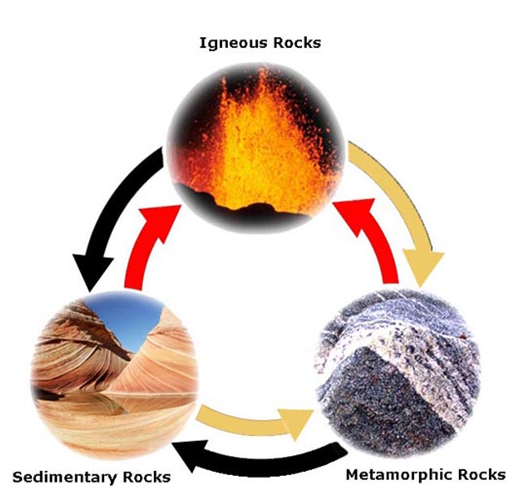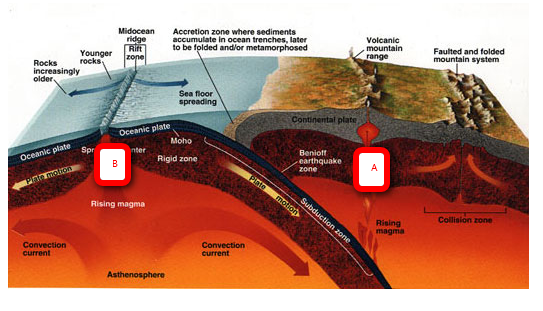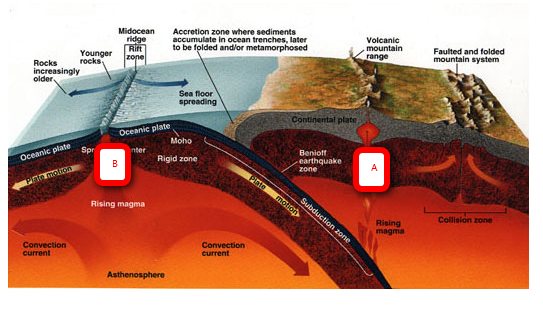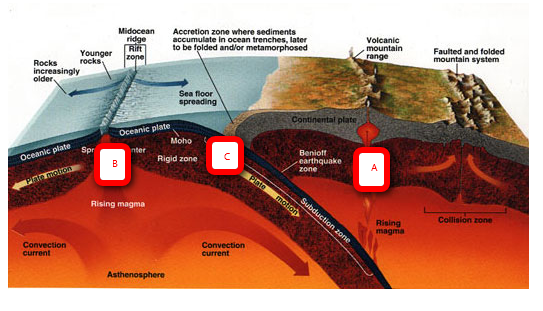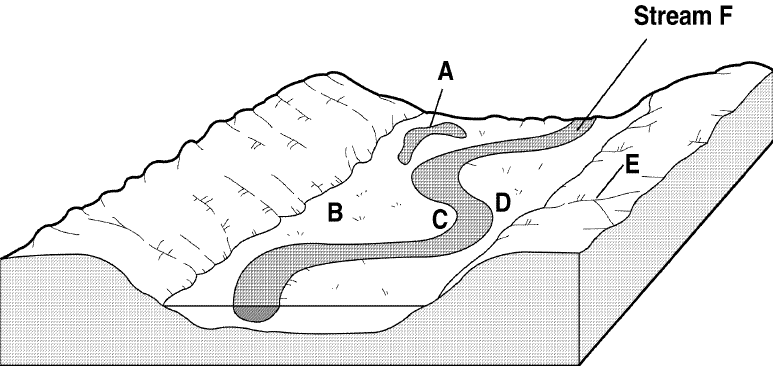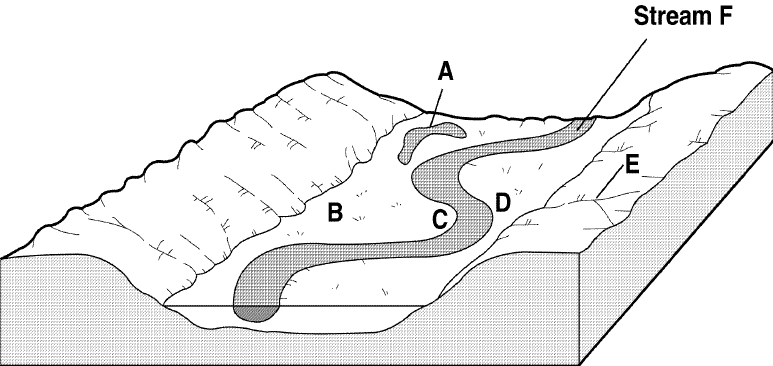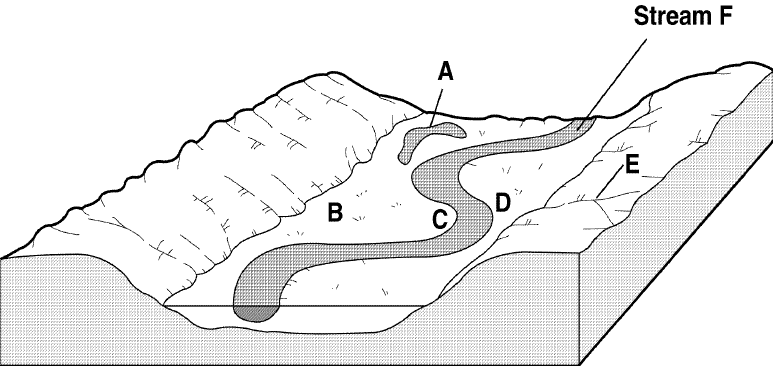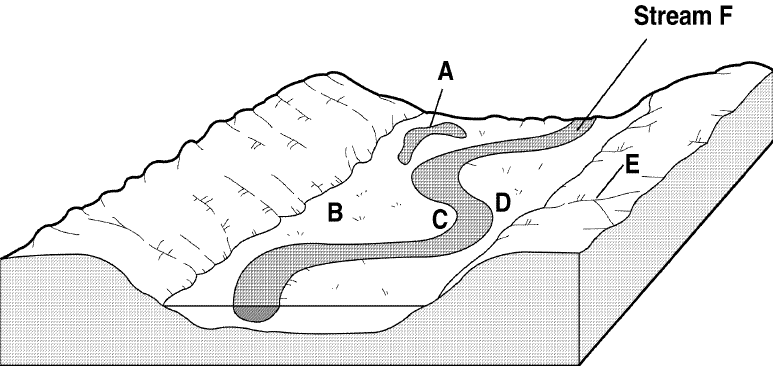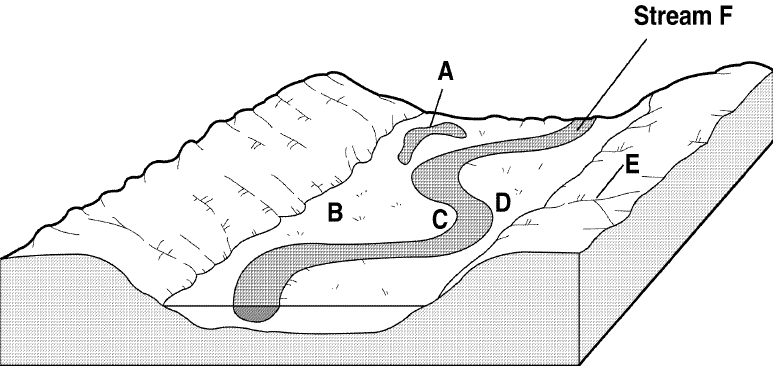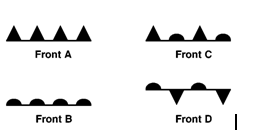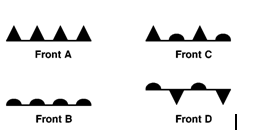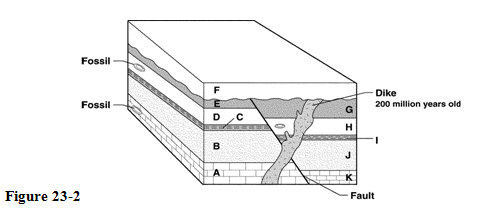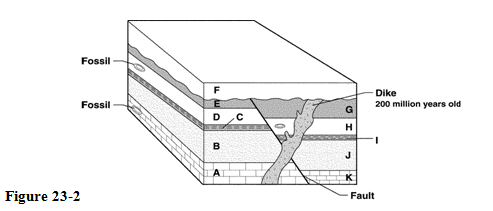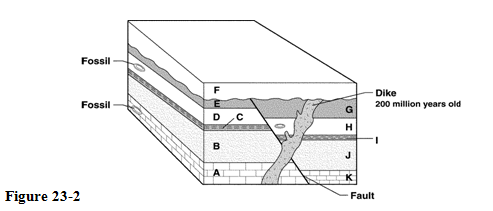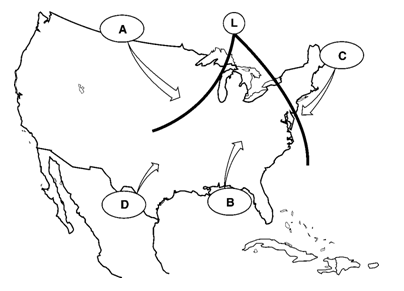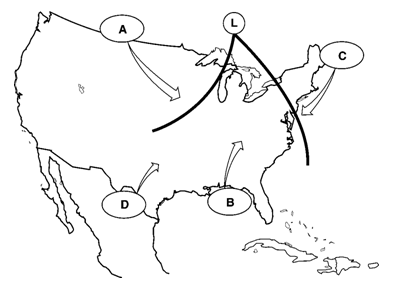Folds, Faults And Rock Deformation! Trivia
(193).jpg)
What do you know about folds, faults, and rock deformation? This quiz can be of assistance. For this quiz, you will be required to understand what forces shape the earth’s surface, where new ocean crusts are formed, what it is called when plates slide past each other without any damage, and what shield volcanoes are. This quiz is all about folds, faults, and rock deformation. You can do it.
- 1.
Forces that shape Earth's surface can be divided into
- A.
Constructive and physical
- B.
Constructive and destructive
- C.
Chemical and destructive
- D.
Chemical and physical
Correct Answer
B. Constructive and destructiveExplanation
Forces that shape Earth's surface can be categorized into constructive and destructive forces. Constructive forces are responsible for building and creating new landforms, such as mountains and valleys, through processes like deposition and uplift. Destructive forces, on the other hand, cause the breakdown and destruction of landforms, such as erosion and weathering. These forces work in opposition to each other, with constructive forces shaping the Earth's surface and destructive forces wearing it down.Rate this question:
-
- 2.
The two layers that make up the lithosphere are the
- A.
Upper mantle and lower mantle
- B.
Oceanic crust and continental crust
- C.
Inner core and outer core
- D.
Crust and upper mantle
Correct Answer
D. Crust and upper mantleExplanation
The lithosphere is made up of two layers: the crust and the upper mantle. The crust is the outermost layer of the Earth and can be divided into two types: oceanic crust and continental crust. The upper mantle is located beneath the crust and is composed of solid rock. Together, these two layers form the lithosphere, which is responsible for the movement of tectonic plates and the formation of Earth's surface features.Rate this question:
-
- 3.
A naturally occurring, inorganic solid with a crystal structure and a characteristic chemical composition is a
- A.
Piece of granite
- B.
Mineral
- C.
Fossil
- D.
Rock
Correct Answer
B. MineralExplanation
A naturally occurring, inorganic solid with a crystal structure and a characteristic chemical composition is referred to as a mineral. Minerals are formed through geological processes and have a specific atomic arrangement, giving them a crystalline structure. They are typically found in rocks and can be identified based on their unique chemical composition. Granite, fossil, and rock are not specific enough to meet all the criteria of a mineral.Rate this question:
-
- 4.
What is a mineral's cleavage?
- A.
The resistance of a mineral to scratching
- B.
A type of fracture in which a mineral breaks along regular, well defined planes
- C.
The color of a minerals powder
- D.
A type of fracture in which a mineral breaks along a curved surface
Correct Answer
B. A type of fracture in which a mineral breaks along regular, well defined planesExplanation
Cleavage refers to the way a mineral breaks along specific planes, creating smooth, flat surfaces. This is different from fracture, which is when a mineral breaks irregularly and does not follow any specific pattern. Cleavage is a characteristic property of minerals and can be used to identify them. It is caused by the arrangement of atoms within the mineral's crystal structure, which determines how easily it breaks along certain planes.Rate this question:
-
- 5.
New ocean crust is formed along
- A.
Trenches
- B.
Mountain belts
- C.
Subduction
- D.
Mid ocean ridge
Correct Answer
D. Mid ocean ridgeExplanation
New ocean crust is formed along mid ocean ridges. These underwater mountain ranges are formed by the movement of tectonic plates, where magma rises from the mantle and solidifies to create new crust. As the plates move apart, the magma continuously fills the gap, leading to the formation of new oceanic crust. This process is known as seafloor spreading and is responsible for the continuous growth of the ocean floor. Therefore, the correct answer is mid ocean ridge.Rate this question:
-
- 6.
Plates slide past each other and crust is neither created nor destroyed at a
- A.
Convergent boundary
- B.
Divergent boundary
- C.
Mid ocean ridge
- D.
Transform boundary
Correct Answer
D. Transform boundaryExplanation
At a transform boundary, plates slide past each other horizontally in opposite directions. This movement is known as shear. Unlike at convergent or divergent boundaries where crust is either created or destroyed, at a transform boundary, crust is neither created nor destroyed. Instead, the plates simply grind against each other, causing earthquakes and the formation of faults. This explanation aligns with the characteristics of a transform boundary and explains why it is the correct answer.Rate this question:
-
- 7.
What is a break in a rock mass along which movement occurs?
- A.
Fold
- B.
Earthquake
- C.
Fault
- D.
Epicenter
Correct Answer
C. FaultExplanation
A fault is a break in a rock mass along which movement occurs. It is a fracture in the Earth's crust where there has been displacement of rock on either side. Faults are commonly associated with earthquakes as the movement along the fault releases energy, causing the ground to shake. This movement can be vertical, horizontal, or a combination of both. Faults play a significant role in shaping the Earth's surface and are important in the study of tectonic plates and seismic activity.Rate this question:
-
- 8.
P waves
- A.
Cause Earth to vibrate in the direction of the wave
- B.
Cause Earth to vibrate at right angles to the direction the wave moves
- C.
Travel along Earth's surface
- D.
Move in a rolling motion similar to ocean waves
Correct Answer
A. Cause Earth to vibrate in the direction of the waveExplanation
P waves, also known as primary waves, are a type of seismic wave that travel through the Earth's interior. These waves cause particles in the Earth to vibrate in the same direction as the wave itself. This means that as the P wave passes through the Earth, the particles move back and forth parallel to the direction of the wave. This is why P waves are classified as compressional waves, as they cause compression and rarefaction of the material they pass through. Therefore, the correct answer is that P waves cause Earth to vibrate in the direction of the wave.Rate this question:
-
- 9.
Geologists have inferred that Earth's outer core is liquid because
- A.
P waves cannot pass through the core
- B.
S waves speed up in the outer core
- C.
S waves are bent downward as they travel through the outer core
- D.
S waves cannot pass through the outer core
Correct Answer
D. S waves cannot pass through the outer coreExplanation
S waves cannot pass through the outer core because they are shear waves that require a solid medium to propagate. Since S waves do not reach the other side of the outer core, it suggests that the outer core is not solid, but rather a liquid. This inference is supported by the fact that P waves can pass through the outer core, indicating that it must be a different state of matter than the inner core.Rate this question:
-
- 10.
What causes the magma inside a volcano to rise towards the surface?
- A.
It is cooler than the surrounding rock
- B.
It is less dense than the surrounding rock
- C.
It does not contain dissolved gases
- D.
It is a thick liquid, denser than the surrounding rock
Correct Answer
B. It is less dense than the surrounding rockExplanation
Magma rises towards the surface of a volcano because it is less dense than the surrounding rock. Density is a measure of how much mass is contained within a given volume. Magma is formed from molten rock deep within the Earth's mantle. As it rises, it encounters rock that is more dense than itself. This density contrast causes the magma to buoyantly rise towards the surface, similar to how a less dense object floats in a denser medium.Rate this question:
-
- 11.
Shield volcanoes are produced by
- A.
Explosive eruptions of lava and ash
- B.
Quiet eruptions of lava
- C.
Explosive eruptions of ash and cinders
- D.
Quiet eruptions that alternate with explosive eruptions
Correct Answer
B. Quiet eruptions of lavaExplanation
Shield volcanoes are produced by quiet eruptions of lava. Unlike explosive eruptions, which are characterized by the ejection of ash, cinders, and other volcanic materials, quiet eruptions release lava in a relatively calm and steady manner. The lava flows out of the volcano and spreads out in thin layers, creating a broad, gently sloping shape that resembles a shield. This type of eruption is common in hotspot areas, where the heat from the Earth's mantle causes the crust to melt and form magma. As the magma rises to the surface, it erupts as lava, gradually building up the shield volcano over time.Rate this question:
-
- 12.
What processes are involved in erosion?
- A.
Precipitation, evaporation and condensation
- B.
Weathering, runoff and transpiration
- C.
Weathering, evaporation and runoff
- D.
Weathering, the force of gravity and wind
Correct Answer
D. Weathering, the force of gravity and windExplanation
Erosion is the process of wearing away or breaking down rocks and soil. Weathering refers to the physical or chemical processes that break down rocks into smaller pieces. The force of gravity plays a role in erosion by causing the movement of rocks and soil downhill. Wind can also contribute to erosion by picking up and carrying away loose particles. Therefore, weathering, the force of gravity, and wind are the processes involved in erosion.Rate this question:
-
- 13.
A layer of permeable rock that is saturated with water is called a
- A.
Water table
- B.
Lake
- C.
Watershed
- D.
Aquifer
Correct Answer
D. AquiferExplanation
An aquifer is a layer of permeable rock that is saturated with water. It acts as a natural underground reservoir, storing and transmitting groundwater. The water table, on the other hand, refers to the level below which the ground is saturated with water. A lake is a body of water surrounded by land, and a watershed is an area of land where all the water drains into a specific water system. Therefore, the correct answer is aquifer, as it specifically refers to a saturated layer of rock that stores water.Rate this question:
-
- 14.
Tilted telephone poles and fences curving in a downward direction on a hillside are evidence of
- A.
A landslide
- B.
Creep
- C.
A mudflow
- D.
A slump
Correct Answer
B. CreepExplanation
The presence of tilted telephone poles and fences curving in a downward direction on a hillside indicates creep. Creep is a slow, gradual movement of soil or rock downhill due to the force of gravity. It causes structures like telephone poles and fences to tilt and curve as the ground slowly moves. This phenomenon is different from a landslide, mudflow, or slump, which involve more sudden and dramatic movements of soil or rock.Rate this question:
-
- 15.
Meanders, V-shaped valleys, and oxbow lakes are all features formed by
- A.
Water erosion
- B.
Glaciers
- C.
Water deposition
- D.
Groundwater erosion
Correct Answer
A. Water erosionExplanation
Meanders, V-shaped valleys, and oxbow lakes are all landforms that are created by the erosive action of water. Meanders are winding curves or bends in a river, formed as the water erodes the outer bank and deposits sediment on the inner bank. V-shaped valleys are formed when water erodes the sides of a river or stream channel, creating steep, narrow valley walls. Oxbow lakes are formed when a meander in a river gets cut off from the main channel, leaving a curved lake. Therefore, the correct answer is water erosion.Rate this question:
-
- 16.
Wind erodes the land by
- A.
Deflation and oxidation
- B.
Abrasion and chemical weathering
- C.
Deflation and plucking
- D.
Deflation and abrasion
Correct Answer
D. Deflation and abrasionExplanation
Wind erodes the land through deflation, which is the process of removing loose particles from the surface, and abrasion, which involves the wearing down of rocks and surfaces by the movement of these particles. As the wind blows, it picks up and carries loose particles, such as sand and dust, and these particles then collide with the land surface, causing abrasion. Over time, this constant abrasion can wear down rocks and other landforms, leading to erosion. Therefore, deflation and abrasion are the correct processes involved in wind erosion.Rate this question:
-
- 17.
Surface currents in the ocean are caused by
- A.
Wind blowing across the ocean surface
- B.
Density differences of ocean water
- C.
Salinity changes with depth
- D.
Deep upwelling
Correct Answer
A. Wind blowing across the ocean surfaceExplanation
Surface currents in the ocean are primarily caused by the wind blowing across the ocean surface. As the wind moves over the water, it creates friction, which in turn transfers energy to the water. This energy causes the water to move in the same direction as the wind, creating surface currents. While density differences, salinity changes, and deep upwelling can also influence ocean currents, they are not the primary cause.Rate this question:
-
- 18.
As altitude increases
- A.
Air pressure decreases and density increases
- B.
Air pressure increases and density decreases
- C.
Air pressure and density increase
- D.
Air pressure decreases and density decreases
Correct Answer
D. Air pressure decreases and density decreasesExplanation
As altitude increases, the air pressure decreases because there is less atmosphere above to exert pressure. Additionally, the density of the air also decreases because there are fewer air molecules in a given volume at higher altitudes. Therefore, the correct answer is that as altitude increases, both air pressure and density decrease.Rate this question:
-
- 19.
What is the process that moves sand along a shore?
- A.
Abrasion
- B.
Hydraulic action
- C.
A spit
- D.
Longshore drift
Correct Answer
D. Longshore driftExplanation
Longshore drift is the process that moves sand along a shore. It occurs when waves approach the shore at an angle, carrying sediment with them. As the waves break, the sediment is pushed up the beach at an angle, and then pulled back down by gravity. This zigzag movement of sediment along the shoreline is known as longshore drift. It is an important process in shaping coastal features and can result in the formation of sandbars, spits, and beaches.Rate this question:
-
- 20.
Which of the following is an example of a feature caused by wave erosion?
- A.
Delta
- B.
Alluvial fan
- C.
Sea stack
- D.
Spit
Correct Answer
C. Sea stackExplanation
A sea stack is an example of a feature caused by wave erosion. Wave erosion occurs when waves continuously crash against a rocky coastline, gradually wearing away the rock. Over time, this erosion can create unique landforms such as sea stacks. Sea stacks are isolated columns of rock that are left standing after the surrounding rock has been eroded away by the relentless pounding of waves. They are often found along coastlines with high wave energy and are a striking example of the power of wave erosion in shaping the Earth's surface.Rate this question:
-
- 21.
As Earth completes one orbit around the sun, it has completed one
- A.
Rotation
- B.
Year
- C.
Revolution
- D.
Both b and c
Correct Answer
D. Both b and cExplanation
As Earth completes one orbit around the sun, it has completed one year. This is because a year is defined as the time it takes for a planet to complete one orbit around its star. Additionally, Earth also completes one rotation on its axis during this time, which is why both options b and c are correct.Rate this question:
-
- 22.
Which letter represents heat and pressure forming metamorphic rock?
- A.
E
- B.
F
- C.
A
- D.
C
Correct Answer
A. EExplanation
The letter E represents heat and pressure forming metamorphic rock. Heat and pressure are the two main agents responsible for the formation of metamorphic rock. When rocks are subjected to high temperatures and pressure, their mineral composition and texture change, resulting in the formation of metamorphic rock. Therefore, E is the correct answer as it represents the process of heat and pressure causing metamorphism.Rate this question:
-
- 23.
What must happen in order for metamorphic rock to turn into igneous rock?
- A.
Heat and pressure applied
- B.
Magma cools
- C.
Rock breaks down
- D.
Melting
Correct Answer
B. Magma coolsExplanation
For metamorphic rock to turn into igneous rock, the magma needs to cool down. This cooling process causes the molten rock to solidify and form new igneous rock. Heat and pressure are typically associated with the formation of metamorphic rock, but in order for the transformation to occur, the rock must be exposed to cooling magma. This cooling allows the rock to undergo a chemical and physical change, transitioning from a metamorphic state to an igneous state.Rate this question:
-
- 24.
What is being formed at point A?
- A.
Earthquake
- B.
Alluvial fan
- C.
Delta
- D.
Volcano
Correct Answer
D. VolcanoExplanation
At point A, a volcano is being formed. This is indicated by the options provided, which include earthquake, alluvial fan, delta, and volcano. Out of these options, a volcano is the only geological feature that is formed by the eruption of molten rock, ash, and gases from beneath the Earth's surface. Therefore, the correct answer is volcano.Rate this question:
-
- 25.
What is occuring at point B?
- A.
Sea floor spreading
- B.
Volcano formation
- C.
Trench formation
- D.
Earthquake
Correct Answer
A. Sea floor spreadingExplanation
At point B, sea floor spreading is occurring. This is the process where new oceanic crust is formed at mid-ocean ridges as tectonic plates move apart. Magma rises to the surface, cools, and solidifies, creating new crust. This process is responsible for the continuous expansion of the ocean floor and the movement of continents over time. It is an important mechanism in plate tectonics and the formation of new ocean basins.Rate this question:
-
- 26.
What type of plate boundary is represented by letter C?
- A.
Divergent
- B.
Convergent
- C.
Transform
- D.
Fault
Correct Answer
B. ConvergentExplanation
Letter C represents a convergent plate boundary. This type of boundary occurs when two tectonic plates collide and are forced together. The collision can result in the formation of mountains, volcanic activity, or the subduction of one plate beneath the other. In a convergent boundary, the plates are moving towards each other, causing compression and intense geological activity. This is in contrast to divergent boundaries, where plates move apart, and transform boundaries, where plates slide past each other horizontally. Faults, on the other hand, refer to fractures in the Earth's crust and are not specific to plate boundaries.Rate this question:
-
- 27.
Is the stream flow moving faster at point C or point D?
- A.
C
- B.
D
- C.
Both the same
- D.
Can't tell from the picture
Correct Answer
B. DExplanation
Based on the given information, it is not possible to determine whether the stream flow is moving faster at point C or point D. The picture does not provide any visual cues or measurements to determine the speed of the stream flow at these points. Therefore, without additional information, it is impossible to make a conclusive judgment.Rate this question:
-
- 28.
What is the feature labeled A?
- A.
Stream
- B.
Alluvial fan
- C.
Oxbow lake
- D.
Floodplain
Correct Answer
C. Oxbow lakeExplanation
The feature labeled A is an oxbow lake. Oxbow lakes are formed when a meandering river bends and curves over time, eventually cutting off a section of the river's channel. This cutoff section then becomes a stagnant body of water, forming a U-shaped lake. Oxbow lakes are typically found near rivers and are characterized by their curved shape and connection to the former river channel.Rate this question:
-
- 29.
Describe the area that forms the floodplain for stream F.
- A.
Delta
- B.
Plateau
- C.
Basin
- D.
Valley
Correct Answer
D. ValleyExplanation
The floodplain for stream F is described as a valley. A valley is a low-lying area between hills or mountains, typically with a river or stream running through it. In the context of a floodplain, it refers to the flat and wide area adjacent to a stream or river that is prone to flooding during periods of high water flow. This explanation suggests that the floodplain for stream F is located in a valley-like topography.Rate this question:
-
- 30.
What are the smaller streams, labeled E, called?
- A.
Rivers
- B.
Oxbows
- C.
Straits
- D.
Tributaries
Correct Answer
D. TributariesExplanation
The smaller streams labeled E are called tributaries. Tributaries are smaller rivers or streams that flow into a larger river or body of water. They contribute to the overall flow and volume of the larger river.Rate this question:
-
- 31.
What process is occurring at D?
- A.
Erosion
- B.
Deposition
- C.
Sedimentation
- D.
Alluvial fan
Correct Answer
A. ErosionExplanation
At location D, erosion is occurring. Erosion is the process of wearing away or removing the Earth's surface materials, such as soil, rocks, or sediments, through the action of wind, water, or ice. It involves the transportation of these materials from one place to another, often leading to the formation of new landforms. In this case, it can be inferred that the forces of wind, water, or ice are actively removing or wearing away the surface materials at location D.Rate this question:
-
- 32.
Round, soliPieces of ice more than 5 millimeters in diameter fall as
- A.
Hail
- B.
Sleet
- C.
Snow
- D.
Freezing rain
Correct Answer
A. HailExplanation
Hail is formed when there are strong updrafts in a thunderstorm that carry raindrops upward into extremely cold areas of the atmosphere. These supercooled water droplets freeze and grow larger as they collide with other supercooled water droplets. Once the hailstones become too heavy for the updrafts to support, they fall to the ground. Hailstones are typically larger than 5 millimeters in diameter, which is why they are the correct answer for this question.Rate this question:
-
- 33.
What type of front forms when two unlike air masses form a boundary but neither is moving?
- A.
Warm
- B.
Cold
- C.
Stationary
- D.
Occluded
Correct Answer
C. StationaryExplanation
When two unlike air masses form a boundary but neither is moving, a stationary front is formed. In a stationary front, the warm and cold air masses are not advancing or retreating, resulting in a prolonged period of unsettled weather conditions. This can lead to extended periods of precipitation and cloud cover as the two air masses interact and mix.Rate this question:
-
- 34.
Which of the following is a weather system with a center of low pressure?
- A.
Cyclone
- B.
Anticyclone
- C.
Cold front
- D.
Warm front
Correct Answer
A. CycloneExplanation
A cyclone is a weather system with a center of low pressure. It is characterized by rotating winds that spiral inward towards the center. This low-pressure system brings about unsettled weather conditions, including strong winds, heavy rainfall, and sometimes thunderstorms. Cyclones can form over both land and water, and they can vary in size and intensity. They are commonly associated with destructive effects, such as storm surges and flooding.Rate this question:
-
- 35.
Which of the symbols represents a warm front?
- A.
A
- B.
B
- C.
D
- D.
D
Correct Answer
B. BExplanation
Symbol B represents a warm front. A warm front occurs when warm air moves into an area previously occupied by cooler air. Symbol B shows a line with semicircles pointing towards the cooler air, indicating that warm air is advancing and replacing the cooler air.Rate this question:
-
- 36.
Which represents a stationary front that is not moving?
- A.
A
- B.
B
- C.
C
- D.
D
Correct Answer
D. DExplanation
Option D represents a stationary front that is not moving. A stationary front occurs when a warm air mass and a cold air mass meet, but neither one is strong enough to push the other. As a result, the front remains stationary and does not move.Rate this question:
-
- 37.
A description of the pattern of weather over many years in a region is ...
- A.
Weather forecast
- B.
Air mass
- C.
Climate
- D.
Weather system
Correct Answer
C. ClimateExplanation
Climate refers to the long-term pattern of weather conditions in a particular region. Unlike weather, which can change from day to day or even hour to hour, climate represents the average weather conditions over a period of many years. It takes into account factors such as temperature, precipitation, humidity, wind patterns, and other atmospheric conditions. Climate is an important consideration for understanding the overall weather patterns and trends in a region, and it helps to determine the types of ecosystems and vegetation that can thrive in that area.Rate this question:
-
- 38.
Which of the following factors affect a region's temperature?
- A.
Longitude and altitude
- B.
Distance from large bodies of water
- C.
Ocean current
- D.
All of the above
Correct Answer
D. All of the aboveExplanation
All of the factors mentioned in the options can affect a region's temperature. Longitude and altitude play a significant role in determining temperature variations as higher altitudes and locations further from the equator tend to be cooler. Distance from large bodies of water can also influence temperature as coastal areas experience milder climates due to the moderating effect of the water. Ocean currents can further impact temperature patterns, as warm currents can raise temperatures in nearby regions while cold currents can lower them. Therefore, all three factors have the potential to affect a region's temperature.Rate this question:
-
- 39.
An example of a long term climate change that occurs naturally is
- A.
Ice age
- B.
El Nino
- C.
Global warming
- D.
Greenhouse effect
Correct Answer
A. Ice ageExplanation
An ice age is an example of a long-term climate change that occurs naturally. It is a period of time when the Earth experiences a significant cooling, resulting in the expansion of ice sheets and glaciers. Ice ages are characterized by lower average temperatures and can last for millions of years. This natural climate change is caused by various factors, such as changes in Earth's orbit, volcanic activity, and variations in solar radiation. Ice ages have occurred throughout Earth's history and have had significant impacts on the planet's ecosystems and biodiversity.Rate this question:
-
- 40.
Which rock layer is the youngest?
- A.
F
- B.
E
- C.
H
- D.
J
Correct Answer
A. FExplanation
The rock layer F is the youngest because in the principle of superposition, which states that in an undisturbed sequence of rocks, the youngest rocks are on top, while the oldest rocks are at the bottom. Since F is the topmost layer among the options given, it is the youngest.Rate this question:
-
- 41.
Compare the age of a fossil found in layer D to one found in layer B.
- A.
The fossil in B would be younger
- B.
You cannot tell from this graphic
- C.
The fossil in D would be younger
- D.
They are about the same age
Correct Answer
C. The fossil in D would be youngerExplanation
Based on the given information, it can be inferred that the age of the fossil found in layer D would be younger. This conclusion is drawn because the question states to compare the age of the fossils in layer D and layer B, and the answer states that the fossil in D would be younger. Therefore, it can be assumed that the fossil in D is of a more recent age compared to the fossil in B.Rate this question:
-
- 42.
Is the fault older or younger than the dike?
- A.
They are approximately the same age
- B.
You cannot tell from this graphic
- C.
The fault is older than the dike
- D.
The fault is younger than the dike
Correct Answer
C. The fault is older than the dikeExplanation
Based on the information given, it is stated that the fault and the dike are approximately the same age. Therefore, the fault cannot be younger than the dike, but it could potentially be older. Hence, the fault is older than the dike.Rate this question:
-
- 43.
What causes clouds to form in the three fronts?
- A.
Cold, dry air rises causing clouds
- B.
Weather fronts always causes clouds
- C.
As warm air rises, it cools and water vapor in the air condenses and forms clouds
- D.
None of the above
Correct Answer
C. As warm air rises, it cools and water vapor in the air condenses and forms cloudsExplanation
When warm air rises, it expands and cools. As it cools, the water vapor in the air condenses and forms tiny water droplets or ice crystals. These tiny droplets or crystals come together to form clouds. Therefore, the correct answer is that as warm air rises, it cools and water vapor in the air condenses and forms clouds.Rate this question:
-
- 44.
Explain what is happening to the two air masses in the cold front.
- A.
The warm air is lifted up by the cold air
- B.
The warm air mass is pushing the cold air down and away
- C.
The air is mixing and the cloud is going away
- D.
Cold, dry air causing clouds
Correct Answer
A. The warm air is lifted up by the cold airExplanation
In a cold front, the warm air mass is lifted up by the cold air. As the cold air advances, it forces the warm air to rise rapidly. This lifting of warm air causes it to cool down, leading to condensation and the formation of clouds. The interaction between the warm and cold air masses results in the development of precipitation and potentially severe weather conditions such as thunderstorms.Rate this question:
-
- 45.
What has happened to the warm air mass in the occluded front?
- A.
It is creating a warm front
- B.
The warm air mass is trapped between two cold air masses, which have forced it to rise
- C.
The warm air mass is dividing a cold air mass in two
- D.
None of the above
Correct Answer
B. The warm air mass is trapped between two cold air masses, which have forced it to riseExplanation
The warm air mass in the occluded front is trapped between two cold air masses, which have forced it to rise. This occurs when a cold front overtakes a warm front, causing the warm air to be lifted off the ground. As the warm air rises, it cools and condenses, leading to the formation of clouds and precipitation. This process is known as occlusion, and it typically results in the dissipation of the warm air mass.Rate this question:
-
- 46.
What factors are used to classify the air masses?
- A.
The state or county they form over
- B.
What ocean they form over
- C.
Whether they form over land or water
- D.
None of the above
Correct Answer
C. Whether they form over land or waterExplanation
Air masses are classified based on whether they form over land or water. This classification is important because air masses that form over land tend to be dry and have different characteristics compared to those that form over water, which are typically moist. This distinction helps meteorologists understand the properties and behavior of different air masses, which in turn affects weather patterns and forecasting.Rate this question:
-
- 47.
Which letter represents a continental polar air mass?
- A.
A
- B.
B
- C.
C
- D.
D
Correct Answer
A. AExplanation
The letter A represents a continental polar air mass. Continental polar air masses form over cold land areas and are characterized by their dry and cold nature. They typically bring cooler temperatures and lower humidity when they move into a region.Rate this question:
-
Quiz Review Timeline +
Our quizzes are rigorously reviewed, monitored and continuously updated by our expert board to maintain accuracy, relevance, and timeliness.
-
Current Version
-
Nov 16, 2023Quiz Edited by
ProProfs Editorial Team -
May 18, 2010Quiz Created by
Jdionne
- Continent Quizzes
- Earth Science Quizzes
- Easy Geography Quizzes
- Environment Quizzes
- Fictional Geography Adults Quizzes
- Five Themes Of Geography Quizzes
- Geology Quizzes
- Human Geography Quizzes
- Imperialism Quizzes
- Island Quizzes
- Land Quizzes
- Latitude And Longitude Quizzes
- Location Quizzes
- Nation Quizzes
- Nature Quizzes
- Navigation Quizzes
- Ocean Quizzes
- Physical Geography Quizzes
- Planet Quizzes
- Regional Geography Quizzes
- Remote Sensing Quizzes
- World Quizzes
- World Geography Quizzes
 Back to top
Back to top



